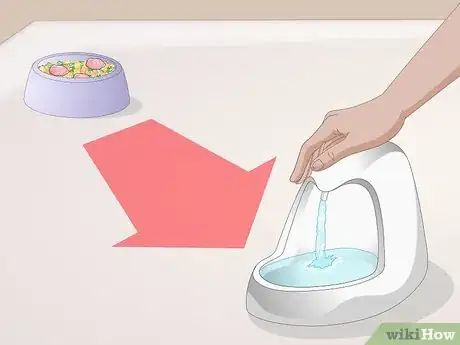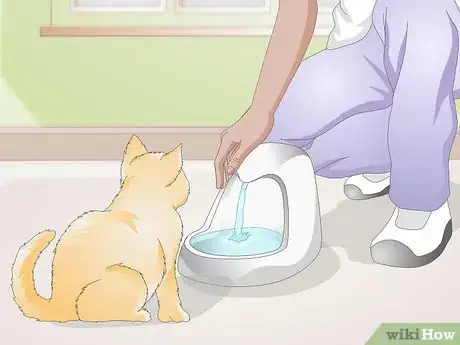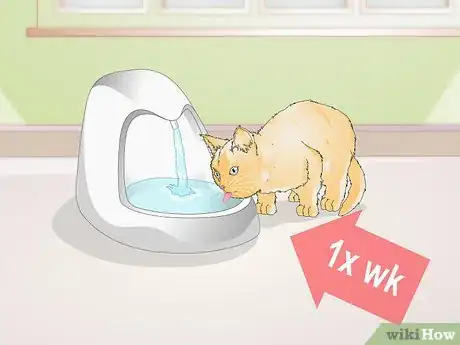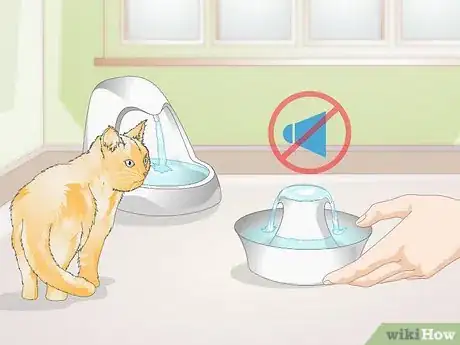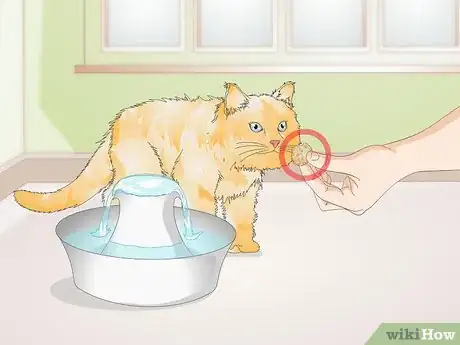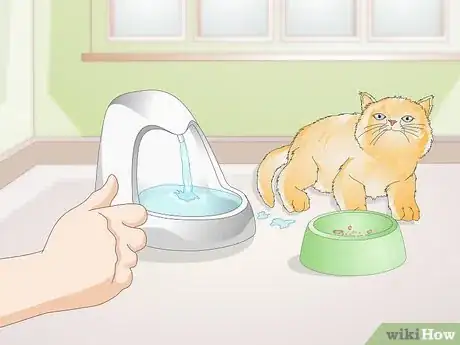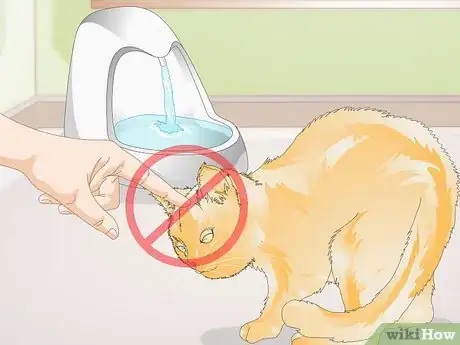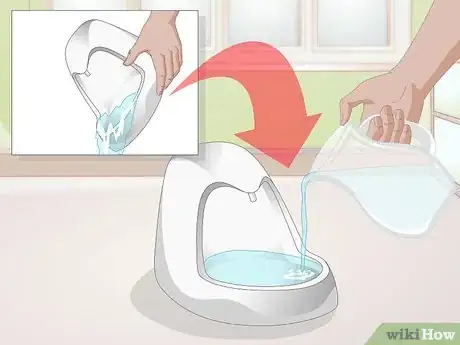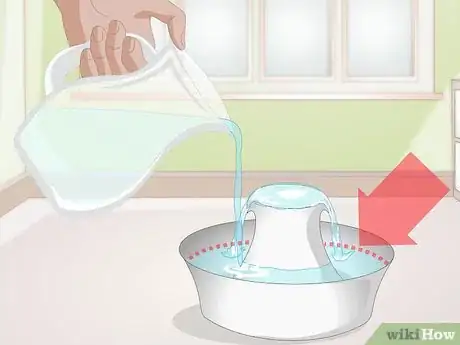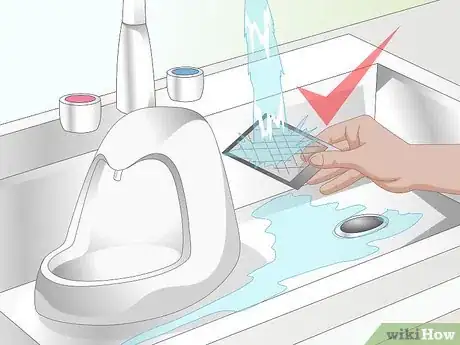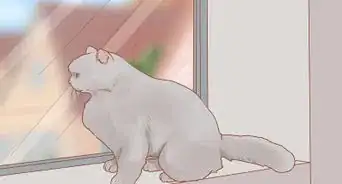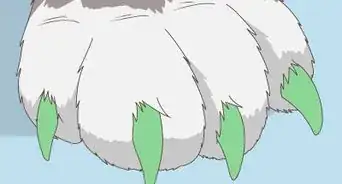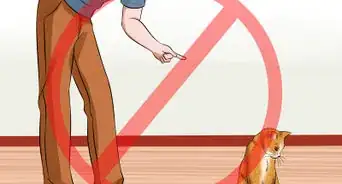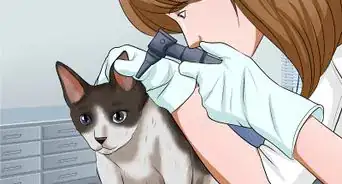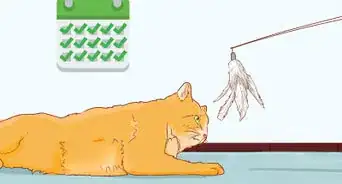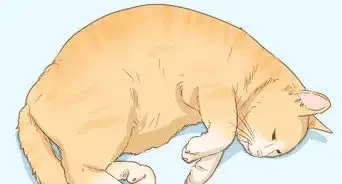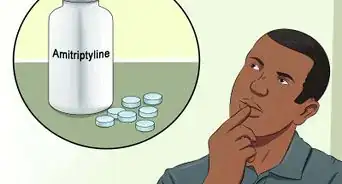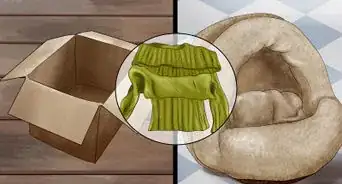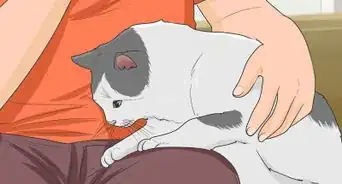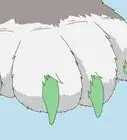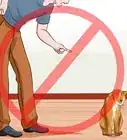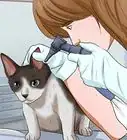This article was co-authored by Jessica Char. Jessica Char is a Cat and Dog Trainer, Behavior Consultant, and the Founder of Feline Engineering and Canine Engineering. She specializes in modifying challenging pet behavior problems, such as fear and aggression, using positive reinforcement training protocols. Jessica is a Certified Fear Free Trainer, a Certified Professional Dog Trainer, and a Certified Separation Anxiety Trainer. She is also a member of the International Association of Animal Behavior Consultants. Jessica received her BS and MS in Biomedical Engineering from Washington University in St. Louis.
There are 9 references cited in this article, which can be found at the bottom of the page.
This article has been viewed 88,461 times.
Pet fountains allow you to not only provide drinking water for your cat, but to incorporate a decorative fountain into your home décor. To train your cat to use a pet fountain, create the right environment by placing the cat fountain well away from litter boxes and food bowls. Let your cat get used to the pet fountain by introducing it while it is off. After your cat gets comfortable around the pet fountain, turn the fountain on a low setting. Continue to increase the fountain pressure to your ideal setting over several weeks. Clean the fountain regularly and stick to the recommended maintenance schedule provided by your fountain's manufacturer.
Steps
Creating the Right Environment
-
1Keep the fountain away from the food bowl. Cats don't naturally locate their food near their drinking water. Plus, if any water splashes from the fountain onto the food, it could cause the food to turn to become damp and mushy. Alternatively, if food gets in the fountain by accident, the water could be contaminated. Place your fountain in a different room than the food bowl.[1]
- For similar reasons, do not place your pet fountain too near the litter box.
-
2Place the pet fountain somewhere your pet feels safe. Cats often spend more time in part of the house than in others. Monitor your pet's behavior carefully to discover if it has a favorite room or space in the house. Place your pet fountain in this favorite space. For instance, your cat might enjoy drinking from the pet fountain in the library, the living room, or even the basement.[2]
- Cat owners often place their pet fountains on tables or stands. Ensure your pet has enough room to move about without knocking the pet fountain over if you choose to place it on a table or stand.
Advertisement -
3Avoid eliminating other sources of water.[3] Although it might seem tempting to remove the cat's water bowl, so as to force them to use the fountain, do not do this. If the cat is frightened or intimidated by the fountain, they may be too fearful to approach it and drink, which could result in dehydration. Many cats are attracted by splashing water, so never fear, the cat will check the fountain out when they feel comfortable enough to do so.
Encouraging Your Cat to Use the Fountain
-
1Let your cat get used to the fountain. Pet fountains make some pets nervous. Fill the fountain, but don't turn it on. Your pet's curiosity will quickly overtake it. Once it begins using the fountain regularly, turn it on once or twice each week. If it has multiple settings, turn it on the lowest setting. As your pet familiarizes itself with the fountain, leave the fountain on more and more often and set it to higher settings.[4]
-
2Get a quieter fountain. Some pet fountains are especially noisy. Fountains made of plastic, especially, tend to be louder and amplify the sound of the fountain motor. Ceramic fountains, on the other hand, are much quieter.[5] If you suspect your pet is scared of the sound of the fountain, try a different model with a lower volume.
- Sometimes loud fountains are consequence of a low water level or a dirty impeller. Clean your fountain's impeller and ensure the water reaches to at least its minimum level.
-
3Reward your cat. When your cat drinks from the pet fountain, give it a small kitty treat. This will create a positive association in your cat's mind with the act of drinking from the pet fountain, and encourage it to continue doing so.[6]
- Give it a treat immediately after it finishes drinking from the pet fountain. Be consistent in rewarding your cat for using the fountain at first.
- Gradually reduce the frequency of your rewards. Over time, offer your cat verbal praise or the chance to play a game after it drinks from the fountain instead of a treat. However, you can still offer a treat now and then.
-
4Don't worry if your cat doesn't drink much. If your pet eats wet food, you may notice that it drinks less than your friends' cats, or less than other pets in your house that eat dry food. But the added water content of wet food means your pet does not need to drink as much water. Cats who eat dry food, on the other hand, will need to drink more water to digest their food properly and stay hydrated.[7]
-
5Do not punish your cat for not drinking from the fountain. If your cat doesn't drink from the fountain, or tries to drink from your dog's water dish, don't yell at your cat, strike it, or place it in its cage. These behaviors will only cause your cat to be fearful and will not encourage it to drink from the fountain.[8] [9]
Getting Your Cat to Drink More Water
-
1Change the water regularly. Even in a pet fountain, where the water is constantly circulating, it is important to change the water often. How often you need to change the water depends on the particular model you purchased. Consult the manufacturer directions for information about how and how often you should change the water. Empty the pet fountain and refill it with a supply of fresh, clean water when necessary.[10]
-
2Keep enough water in the fountain. The pet fountain doesn't need to be filled to the brim, but it should be at or just above the minimum fill line. Pet fountains that are not filled to the appropriate level will overheat and eventually stop working. Always refill the pet fountain with cold water.
-
3Conduct regular maintenance. Pet fountains are complex pieces of machinery and need to be taken care of. This means you should regularly clean your pet fountain's filter (usually every 2-4 weeks) and impeller. Wipe around and under the fountain to prevent mold and moisture buildup.
- Every pet fountain is slightly different. Follow the maintenance directions provided by your fountain's manufacturer to determine how and how often to conduct maintenance on your fountain.
Expert Q&A
-
QuestionWhy won't my cat drink from a water fountain?
 Jessica CharJessica Char is a Cat and Dog Trainer, Behavior Consultant, and the Founder of Feline Engineering and Canine Engineering. She specializes in modifying challenging pet behavior problems, such as fear and aggression, using positive reinforcement training protocols. Jessica is a Certified Fear Free Trainer, a Certified Professional Dog Trainer, and a Certified Separation Anxiety Trainer. She is also a member of the International Association of Animal Behavior Consultants. Jessica received her BS and MS in Biomedical Engineering from Washington University in St. Louis.
Jessica CharJessica Char is a Cat and Dog Trainer, Behavior Consultant, and the Founder of Feline Engineering and Canine Engineering. She specializes in modifying challenging pet behavior problems, such as fear and aggression, using positive reinforcement training protocols. Jessica is a Certified Fear Free Trainer, a Certified Professional Dog Trainer, and a Certified Separation Anxiety Trainer. She is also a member of the International Association of Animal Behavior Consultants. Jessica received her BS and MS in Biomedical Engineering from Washington University in St. Louis.
Cat & Dog Behavior Consultant It may be due to fear, and you might need to consider whether that's the best tool for them. Even though the fountain is recommended in many ways, if your cat is really scared of it, then it's not making their life better to have it.
It may be due to fear, and you might need to consider whether that's the best tool for them. Even though the fountain is recommended in many ways, if your cat is really scared of it, then it's not making their life better to have it. -
QuestionHow do you train a cat to drink water?
 Jessica CharJessica Char is a Cat and Dog Trainer, Behavior Consultant, and the Founder of Feline Engineering and Canine Engineering. She specializes in modifying challenging pet behavior problems, such as fear and aggression, using positive reinforcement training protocols. Jessica is a Certified Fear Free Trainer, a Certified Professional Dog Trainer, and a Certified Separation Anxiety Trainer. She is also a member of the International Association of Animal Behavior Consultants. Jessica received her BS and MS in Biomedical Engineering from Washington University in St. Louis.
Jessica CharJessica Char is a Cat and Dog Trainer, Behavior Consultant, and the Founder of Feline Engineering and Canine Engineering. She specializes in modifying challenging pet behavior problems, such as fear and aggression, using positive reinforcement training protocols. Jessica is a Certified Fear Free Trainer, a Certified Professional Dog Trainer, and a Certified Separation Anxiety Trainer. She is also a member of the International Association of Animal Behavior Consultants. Jessica received her BS and MS in Biomedical Engineering from Washington University in St. Louis.
Cat & Dog Behavior Consultant Leave a regular bowl available to give your cat some alternative when first introducing the fountain. Start with the fountain turned off so the cat learns to drink from it and understands that it's a place to get water before turning it on. If the cat isn't eager to explore on its own, don't force the issue and give him options.
Leave a regular bowl available to give your cat some alternative when first introducing the fountain. Start with the fountain turned off so the cat learns to drink from it and understands that it's a place to get water before turning it on. If the cat isn't eager to explore on its own, don't force the issue and give him options.
References
- ↑ https://www.thirstycatfountains.com/faq/skittish-cats-fountain-use-tips/
- ↑ https://www.petfinder.com/blog/2011/06/you_can_lead_a_cat_to_water/
- ↑ Jessica Char. Cat & Dog Behavior Consultant. Expert Interview. 28 September 2021.
- ↑ https://www.thirstycatfountains.com/faq/skittish-cats-fountain-use-tips/
- ↑ https://www.thirstycatfountains.com/faq/skittish-cats-fountain-use-tips/
- ↑ http://www.humanesociety.org/animals/cats/tips/training_your_cat_positive_reinforcement.html
- ↑ https://www.petfinder.com/cats/cat-nutrition/wet-or-dry-cat-food/
- ↑ http://www.perfectpaws.com/cat_training_and_cat_behavior.html#.V_6BDeArKUk
- ↑ http://www.humanesociety.org/animals/cats/tips/training_your_cat_positive_reinforcement.html
About This Article
Pet fountains are a decorative and healthy way for your cat to stay hydrated. To avoid contaminating the water, place the pet fountain in a separate room from your cat’s food dish, in a place your cat feels safe and comfortable. Don’t get rid of the regular water dish right away, since your cat could become dehydrated. Your cat may need some time to get used to the fountain, so fill the fountain with water but don't turn it on right away. Once your cat begins using the fountain regularly, try turning it on once or twice a week on the lowest setting. Gradually begin leaving the fountain on more often. To learn how to get your cat to drink more water throughout the day, read more from our Veterinary co-author!
